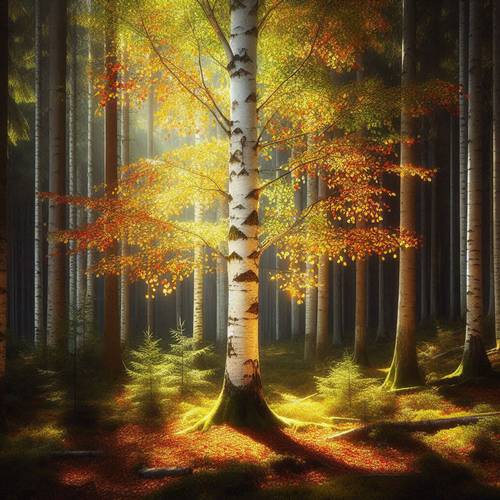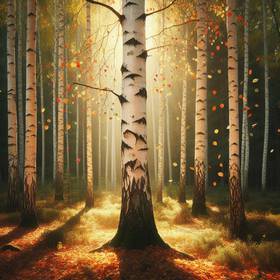Paper Birch
The Paper Birch, a striking symbol of North American woodlands, grows gracefully, reaching heights of 50 to 70 feet with a spread of 30 to 40 feet. Its smooth, white bark, resembling delicate paper, peels away effortlessly, revealing a bright, pristine surface beneath. In autumn, its triangular leaves turn a dazzling yellow, transforming the landscape into a vibrant tapestry of color.
This adaptable tree thrives in well-drained, moist soils, enjoying full sunlight or dappled shade. Its attractive form and brilliant fall display make it a beloved choice for parks, gardens, and naturalized areas.
This adaptable tree thrives in well-drained, moist soils, enjoying full sunlight or dappled shade. Its attractive form and brilliant fall display make it a beloved choice for parks, gardens, and naturalized areas.
River Birch
The River Birch, a multi-stemmed, elegant tree, flourishes along waterways and wetlands, where its roots have constant access to moisture. Reaching heights of 40 to 70 feet, with a spread of 30 to 40 feet, this species boasts eye-catching reddish-brown bark that flakes off, revealing a smooth, coppery surface beneath.
Its delicate, diamond-shaped leaves start as a bronzy-green hue, deepening to rich green in summer, before erupting in a vibrant yellow display in autumn. This adaptable species prefers moist, acidic soils, thriving in both full sun and partial shade. Its versatility and breathtaking foliage make it a popular choice for landscapes near water bodies or in moist, shady areas.
Its delicate, diamond-shaped leaves start as a bronzy-green hue, deepening to rich green in summer, before erupting in a vibrant yellow display in autumn. This adaptable species prefers moist, acidic soils, thriving in both full sun and partial shade. Its versatility and breathtaking foliage make it a popular choice for landscapes near water bodies or in moist, shady areas.
Yellow Birch
The Yellow Birch, a majestic tree with impressive stature, stands tall as a gem of North American forests. Reaching heights of 60 to 80 feet with a spread of 30 to 40 feet, this species is known for its distinctive, golden-yellow bark that peels back in thin, paper-like layers, unveiling a smooth, almost coppery surface beneath.
The oval leaves emerge bronze-green, deepening to rich green in summer before transforming into a dazzling yellow-gold in autumn. This tree thrives in well-drained, moist soils, enjoying full sunlight or dappled shade. Its striking bark, vibrant foliage, and stately form make it a popular choice for parks, gardens, and naturalized settings.
The oval leaves emerge bronze-green, deepening to rich green in summer before transforming into a dazzling yellow-gold in autumn. This tree thrives in well-drained, moist soils, enjoying full sunlight or dappled shade. Its striking bark, vibrant foliage, and stately form make it a popular choice for parks, gardens, and naturalized settings.
European White Birch
The European White Birch, a graceful and elegant tree, is a popular choice for landscapes worldwide. Reaching heights of 50 to 70 feet with a spread of 30 to 40 feet, this species features smooth, white bark that peels back in thin, paper-like layers, revealing a luminous, almost translucent surface beneath.
Deepening to rich green in summer before transforming into a dazzling yellow-gold in autumn. This tree thrives in well-drained, moist soils, enjoying full sunlight or dappled shade. Its captivating form, vibrant foliage, and adaptability make it a beloved choice for gardens, parks, and naturalized areas.
Deepening to rich green in summer before transforming into a dazzling yellow-gold in autumn. This tree thrives in well-drained, moist soils, enjoying full sunlight or dappled shade. Its captivating form, vibrant foliage, and adaptability make it a beloved choice for gardens, parks, and naturalized areas.
Gray Birch
The Gray Birch, a smaller, more compact tree, adds elegance to smaller landscapes. Reaching heights of 30 to 40 feet with a spread of 20 to 30 feet, this species features distinctive, grayish-white bark that is smooth and peels in thin sheets.
Its triangular leaves start light green, deepening to rich green in summer before transforming into yellow-bronze in autumn. This species thrives in well-drained, dry soils, enjoying full sunlight or dappled shade. Its compact size, attractive form, and vibrant foliage make it a popular choice for gardens, parks, and urban settings.
Its triangular leaves start light green, deepening to rich green in summer before transforming into yellow-bronze in autumn. This species thrives in well-drained, dry soils, enjoying full sunlight or dappled shade. Its compact size, attractive form, and vibrant foliage make it a popular choice for gardens, parks, and urban settings.
Sweet Birch
The Sweet Birch, a stately tree with a unique, sweet fragrance, is a prized treasure of North American forests. Reaching heights of 60 to 80 feet with a spread of 30 to 40 feet, this species is known for its distinctive, dark, mahogany-colored bark that peels back in thin layers, revealing a smooth, almost copper-toned surface beneath.
With oval leaves emerge bronze-green, deepening to rich green in summer before transforming into dazzling yellow-gold in autumn. This species thrives in well-drained, moist soils, enjoying full sunlight or dappled shade. Its striking bark, vibrant foliage, and sweet aroma make it a popular choice for parks, gardens, and naturalized settings.
With oval leaves emerge bronze-green, deepening to rich green in summer before transforming into dazzling yellow-gold in autumn. This species thrives in well-drained, moist soils, enjoying full sunlight or dappled shade. Its striking bark, vibrant foliage, and sweet aroma make it a popular choice for parks, gardens, and naturalized settings.
Cherry Birch
The Cherry Birch, a captivating cultivar with rich, dark foliage, adds drama to any landscape. Reaching heights of 30 to 40 feet with a spread of 20 to 30 feet, this tree features distinctive, reddish-brown bark that peels in thin layers, revealing a smooth, almost copper-toned surface beneath.
The leaves start deep maroon, deepening to rich purple in summer before transforming into vibrant bronze-yellow in autumn. This tree thrives in well-drained, moist soils, enjoying full sunlight or dappled shade. Its striking foliage, compact size, and graceful form make it a popular choice for gardens, parks, and urban settings.
The leaves start deep maroon, deepening to rich purple in summer before transforming into vibrant bronze-yellow in autumn. This tree thrives in well-drained, moist soils, enjoying full sunlight or dappled shade. Its striking foliage, compact size, and graceful form make it a popular choice for gardens, parks, and urban settings.
Himalayan Birch
The Himalayan Birch, an impressive tree with a striking presence, originates from the Himalayan region. It can grow to heights of 50 to 80 feet with a spread of 30 to 40 feet. This tree features smooth, white bark that peels away in thin layers, exposing a luminous, nearly translucent surface beneath.
With triangular leaves begin as a light green, deepen to a rich green during the summer, and transform into a brilliant yellow-gold in the fall. This species thrives in well-drained, moist soils and prefers full sunlight or partial shade. Its distinctive bark, vibrant foliage, and elegant form make it a popular choice for gardens, parks, and natural settings.
With triangular leaves begin as a light green, deepen to a rich green during the summer, and transform into a brilliant yellow-gold in the fall. This species thrives in well-drained, moist soils and prefers full sunlight or partial shade. Its distinctive bark, vibrant foliage, and elegant form make it a popular choice for gardens, parks, and natural settings.
Dwarf Birch
The Dwarf Birch is an enchanting, petite tree, ideal for small gardens and rockeries. Growing to a modest height of just 1 to 3 feet and spreading 2 to 4 feet wide, this tree features unique reddish-brown bark that peels in thin layers, revealing a smooth, coppery surface beneath.
The leaves start as a light green, turning a rich green in summer before becoming a vibrant yellow-bronze in autumn. This tree flourishes in well-drained, dry soils and enjoys full sun or partial shade. Its compact size, appealing form, and colorful foliage make it a favored choice for gardens, parks, and urban landscapes.
The leaves start as a light green, turning a rich green in summer before becoming a vibrant yellow-bronze in autumn. This tree flourishes in well-drained, dry soils and enjoys full sun or partial shade. Its compact size, appealing form, and colorful foliage make it a favored choice for gardens, parks, and urban landscapes.



